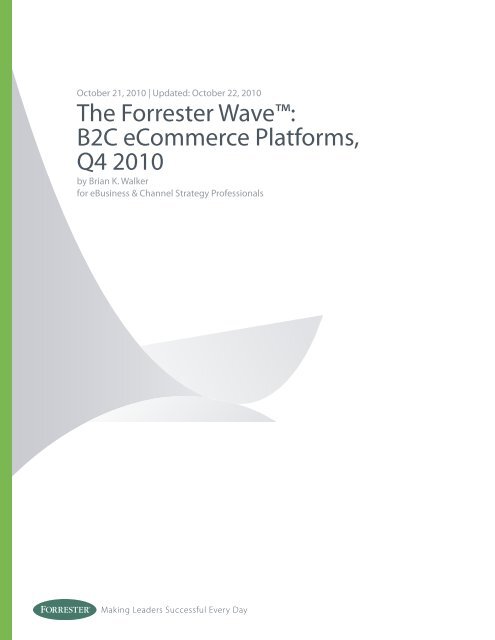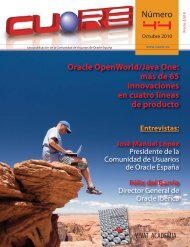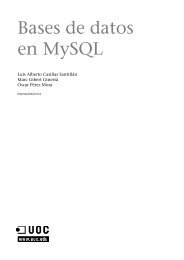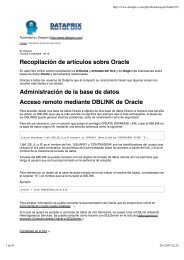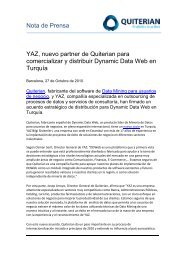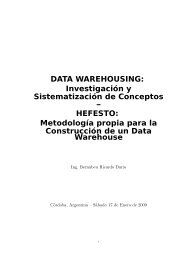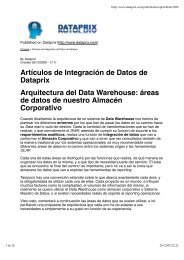Forrester, The Forrester Wave: B2C eCommerce Platforms - Dataprix
Forrester, The Forrester Wave: B2C eCommerce Platforms - Dataprix
Forrester, The Forrester Wave: B2C eCommerce Platforms - Dataprix
Create successful ePaper yourself
Turn your PDF publications into a flip-book with our unique Google optimized e-Paper software.
<strong>The</strong> <strong>Forrester</strong> <strong>Wave</strong>: <strong>B2C</strong> <strong>eCommerce</strong> <strong>Platforms</strong>, Q4 2010For eBusiness & Channel Strategy Professionals11to be extended and customized. Business user tools such as the IBM Management Center havebeen evolved and, in some cases, are industry-leading. IBM has a rich product strategy focusedon core product enhancements as well as building out a comprehensive suite of multichannelcapabilities leveraging its recent acquisitions of Sterling Commerce, Coremetrics, and Unica. Italso has a number of visionary <strong>eCommerce</strong> capabilities — some through its tight integrationwith Coremetrics. However, the flexibility of the IBM product must be carefully leveraged toavoid the risk of increased total cost of ownership (TCO). A SaaS offering — such as the onethat IBM has recently developed in China — offers a packaged <strong>eCommerce</strong>-oriented solutionthat can help to solve this. It remains to be seen how a SaaS offering may complicate IBM’srelationship with its large group of SIs and solution providers.· Hybris. Hybris has had a very strong year and a half since our last comprehensive evaluation,with significant updates to the management tools and scalability. Hybris has also formed a closekey partnership with Endeca to combine the Endeca search and navigation products with hybris’commerce capabilities and has developed strong SIs to support clients in North America inaddition to Europe. Hybris’ key differentiators are in strong product content management tools,catalog management, enterprise integration, and globalization/internationalization capabilities.<strong>eCommerce</strong> features are well represented, and there is a well-defined ability to extend theproduct and customize it to develop differentiated <strong>eCommerce</strong> sites across a variety of verticals.Hybris is a young company that is growing quickly, raising the potential for overcommitment toclients by hybris or partners.· ATG. ATG continues to be a leader in <strong>B2C</strong> <strong>eCommerce</strong> platform solutions, as evidenced by theaddition of more than 125 new customers in the past 12 months. ATG combines a strong andwell-rounded <strong>eCommerce</strong> feature set with an array of targeting, personalization, and customerinteraction tools. ATG has a strong ability to integrate into the enterprise and provides strongmultichannel capabilities, including its Live Help products that include click to call, click tochat, and email response. ATG maintains a strong vision for the product and a focus on the<strong>B2C</strong> <strong>eCommerce</strong> customer needs, pushing its product forward in a consistent manner. ATG hasimproved the hosted/managed and SaaS offerings but must continue to drive stable, repeatable,quality implementations through its reference stores and SI-program development. ATG hasthe opportunity to deliver rich multichannel capabilities to clients but will need to improveproduct content management and order management components of its solutions to completethat vision. In September 2010, ATG announced availability of ATG Commerce 10. <strong>The</strong>secapabilities were not included in our evaluation.· Demandware. Demandware continues to mature as a platform with improved businessmanagement tools and enablement of customized sites through its SaaS platform. Demandwarehas a strong vision for the platform, which, if executed, will position it well in the future as firmsenable <strong>eCommerce</strong> through an evermore diverse set of customer touchpoints. Demandware’sLINK program has also been an innovation enabling third-party point solution providers to© 2010, <strong>Forrester</strong> Research, Inc. Reproduction Prohibited October 21, 2010 | Updated: October 22, 2010
<strong>The</strong> <strong>Forrester</strong> <strong>Wave</strong>: <strong>B2C</strong> <strong>eCommerce</strong> <strong>Platforms</strong>, Q4 2010For eBusiness & Channel Strategy Professionals13<strong>eCommerce</strong> requirements that differ from those of other <strong>B2C</strong> <strong>eCommerce</strong> verticals. As a result,areas such as WCM, product content management, and order management receive much lessfocus or will require third-party solutions. Verticals such as telecom or clients looking for ahighly customizable solution upon which to build an <strong>eCommerce</strong> platform may also find ElasticPath compelling. Uniquely, Elastic Path ships source code with its application and leveragesmany common open source frameworks and products enabling developers to often pick up theproduct quickly. However, solutions are typically delivered through Elastic Path’s professionalservices organization, but may also be implemented internally by clients or through SIs.Contenders Have Unique Opportunities For Some Companies To Leverage· MarketLive. MarketLive offers a competent product aimed at the midmarket <strong>eCommerce</strong>retailer. <strong>eCommerce</strong> capabilities and business user tools have improved since our last evaluationbut lack the depth of other enterprise solutions. However, for the smaller online retail operation,MarketLive can be a very good option, with a solid <strong>eCommerce</strong> retail capability set andmaturing services to support marketing, analytics, and site optimization.· Venda. Venda offers a straightforward set of tools and features well suited to midsizedclients looking for a SaaS solution, but with simplified requirements around content, ordermanagement, and service. Venda has found a solid niche with branded manufacturers ormidsize retailers and has focused on their specific needs. Larger enterprises looking to launch<strong>eCommerce</strong> for a division or smaller brand may also find Venda compelling. With a uniquemodel combining flat-rate subscriptions per site with transaction fees, Venda can be a costeffectivealternative for many businesses. Maturation around content, merchandising, and ordermanagement will be needed to solve for more complex client needs.· Escalate Retail. Escalate Retail is a collection of four formerly distinct companies: Blue Martini,Ecometry, GERS, and ADS Retail. On paper, this combination makes for a dynamic capabilityset able to meet the <strong>eCommerce</strong>, OMS, and CRM requirements of retailers looking to embracemultichannel retailing. However, Escalate Retail’s Blue Martini Commerce Suite product has notkept pace with competitors in the market, with old and largely difficult-to-use merchandising,marketing, and testing tools. Escalate Retail has signaled that it will significantly overhaul theproduct and focus on <strong>eCommerce</strong> business enablement, which will be important for futureclients. Escalate Retail offers strong order management tools, which can position it well if thecore commerce engine and business tools can improve to meet today’s business needs.· Microsoft. Microsoft’s Commerce Server (CS) 2009 product is unique within this evaluationand represents a bit of an apples-to-oranges comparison. As an analogy, think of the otherproducts in our <strong>B2C</strong> enterprise <strong>eCommerce</strong> platform evaluation as various kinds of cars,whereas CS 2009 may best be seen as an engine that, when combined with other Microsoftproducts, can be made into a car, a boat, or a tank. As a result, basic <strong>eCommerce</strong> business toolsare underdeveloped or absent and rely heavily on other Microsoft products such as SharePoint© 2010, <strong>Forrester</strong> Research, Inc. Reproduction Prohibited October 21, 2010 | Updated: October 22, 2010
<strong>The</strong> <strong>Forrester</strong> <strong>Wave</strong>: <strong>B2C</strong> <strong>eCommerce</strong> <strong>Platforms</strong>, Q4 2010For eBusiness & Channel Strategy Professionals15Supplemental MATERIALOnline Resource<strong>The</strong> online version of Figure 3 is an Excel-based vendor comparison tool that provides detailedproduct evaluations and customizable rankings.Data Sources Used In This <strong>Forrester</strong> <strong>Wave</strong><strong>Forrester</strong> used a combination of four data sources to assess the strengths and weaknesses of eachsolution:· Hands-on scenario-based lab evaluations. Vendors spent one day with a team of analysts whoperformed a hands-on evaluation of the product using a scenario-based testing methodology.We evaluated each product using the same scenario(s), creating a level playing field byevaluating every product on the same criteria. Scenarios for this evaluation focused on routine<strong>eCommerce</strong> management and content tasks. For more on scenario-based evaluation, refer toour report on the scenario-based <strong>eCommerce</strong> technology evaluation process. 10· Vendor surveys. <strong>Forrester</strong> surveyed vendors on their capabilities as they relate to the evaluationcriteria. Once we analyzed the completed vendor surveys, we conducted vendor calls wherenecessary to gather details of vendor qualifications.· Product demos. We asked vendors to conduct demonstrations of their product’s functionality.We used findings from these product demos to validate details of each vendor’s productcapabilities. Demos for this evaluation focused on core <strong>eCommerce</strong> features, differentiation ofthe products, and the business-user tools used to manage client sites.· Customer reference calls. To validate product and vendor qualifications, <strong>Forrester</strong> alsoconducted reference calls with two of each vendor’s current customers.<strong>The</strong> <strong>Forrester</strong> <strong>Wave</strong> MethodologyWe conduct primary research to develop a list of vendors that meet our criteria to be evaluatedin this market. From that initial pool of vendors, we then narrow our final list. We choose thesevendors based on: 1) product fit; 2) customer success; and 3) <strong>Forrester</strong> client demand. We eliminatevendors that have limited customer references and products that don’t fit the scope of our evaluation.After examining past research, user need assessments, and vendor and expert interviews, we developthe initial evaluation criteria. To evaluate the vendors and their products against our set of criteria,we gather details of product qualifications through a combination of lab evaluations, questionnaires,demos, and/or discussions with client references. We send evaluations to the vendors for their review,and we adjust the evaluations to provide the most accurate view of vendor offerings and strategies.© 2010, <strong>Forrester</strong> Research, Inc. Reproduction Prohibited October 21, 2010 | Updated: October 22, 2010
16<strong>The</strong> <strong>Forrester</strong> <strong>Wave</strong>: <strong>B2C</strong> <strong>eCommerce</strong> <strong>Platforms</strong>, Q4 2010For eBusiness & Channel Strategy ProfessionalsWe set default weightings to reflect our analysis of the needs of large user companies — and/orother scenarios as outlined in the <strong>Forrester</strong> <strong>Wave</strong> document — and then score the vendors basedon a clearly defined scale. <strong>The</strong>se default weightings are intended only as a starting point, and weencourage readers to adapt the weightings to fit their individual needs through the Excel-basedtool. <strong>The</strong> final scores generate the graphical depiction of the market based on current offering,strategy, and market presence. <strong>Forrester</strong> intends to update vendor evaluations regularly as productcapabilities and vendor strategies evolve.Endnotes1In <strong>Forrester</strong>’s Q4 2009 US Retail Executive Online Survey, we asked 291 online retailers how theirinvestment in <strong>eCommerce</strong> technology was changing: 57% reported increasing or significantly increasingtheir technology budget headed into the new year. Conversely, a mere 5% reported decreasing budgetsin the face of the recession. For more information and for an outlook on Australian <strong>eCommerce</strong>, see theJanuary 14, 2010, “2010 US Online Retail Technology Investment Outlook” report, and see the August 19,2010, “Online Retailing In Australia 2010: Technology Investment” report.2For more on the development of an <strong>eCommerce</strong> replatforming business case, see the September 29, 2008,“How To Pitch <strong>eCommerce</strong> Replatforming” report.3<strong>The</strong> call-center-based ordering via the <strong>eCommerce</strong> system takes a variety of flavors, from simply using theWeb site on the customer’s behalf to having a separate Web site for the CSRs to use that is optimized moreto their needs or having thin-client Web-based applications leveraging the <strong>eCommerce</strong> systems servicescomplete with keyboard shortcuts and personalized interfaces.4For an overview of digital-goods-focused commerce solutions, see the May 5, 2009, “Market Overview:Digital <strong>eCommerce</strong> Solutions” report.5For an overview of B2B <strong>eCommerce</strong> platforms, see the December 7, 2009, “Market Overview: B2B<strong>eCommerce</strong> <strong>Platforms</strong>” report.6For an overview of SMB-oriented <strong>eCommerce</strong> solutions, see the July 26, 2010, “Market Overview: SMB<strong>eCommerce</strong> Solutions” report.7For an overview of the full-service <strong>eCommerce</strong> solutions marketplace, see the October 31, 2008, “MarketOverview: Full-Service <strong>eCommerce</strong> Solutions” report.8For an overview of digital-goods-focused commerce solutions, see the May 5, 2009, “Market Overview:Digital <strong>eCommerce</strong> Solutions” report.9Note that hosted/managed and SaaS offerings from ATG and IBM differ in some ways from the fullenterprisesoftware licensed product.10For more on using scenarios in technology evaluation, see the May 17, 2010, “Scenario-Based <strong>eCommerce</strong>Technology Evaluation Process” report.October 21, 2010 | Updated: October 22, 2010© 2010, <strong>Forrester</strong> Research, Inc. Reproduction Prohibited
Making Leaders Successful Every DayHeadquarters<strong>Forrester</strong> Research, Inc.400 Technology SquareCambridge, MA 02139 USATel: +1 617.613.6000Fax: +1 617.613.5000Email: forrester@forrester.comNasdaq symbol: FORRwww.forrester.comResearch and Sales Offices<strong>Forrester</strong> has research centers and sales offices in more than 27 citiesinternationally, including Amsterdam; Cambridge, Mass.; Dallas; Dubai;Foster City, Calif.; Frankfurt; London; Madrid; Sydney; Tel Aviv; and Toronto.For a complete list of worldwide locationsvisit www.forrester.com/about.For information on hard-copy or electronic reprints, please contact Client Supportat +1 866.367.7378, +1 617.613.5730, or clientsupport@forrester.com.We offer quantity discounts and special pricing for academic and nonprofit institutions.<strong>Forrester</strong> Research, Inc. (Nasdaq: FORR)is an independent research companythat provides pragmatic and forwardthinkingadvice to global leaders inbusiness and technology. <strong>Forrester</strong>works with professionals in 19 key rolesat major companies providingproprietary research, customer insight,consulting, events, and peer-to-peerexecutive programs. For more than 27years, <strong>Forrester</strong> has been making IT,marketing, and technology industryleaders successful every day. For moreinformation, visit www.forrester.com.57837


